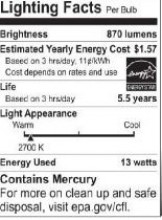By neepenergy | Wed, November 23, 11

Photo courtesy of LUMEN.org
Light at the end of the Standards Tunnel
It’s not hard to master the new age of lighting. Understanding a couple of basic concepts and tools should help you be a more educated and satisfied lighting consumer. If I’m successful, after reading this, you’ll be equipped to navigate the various options available.Key Metrics of Lighting
Brightness =Lumens A light bulb’s brightness is measured by its lumen output. The more lumens, the brighter the bulb. A traditional 60 Watt incandescent bulb provides approximately 800 lumens. To learn more about lumen levels for traditional lamp wattages, see these charts: chart/ chart2. What’s important to remember is to shop for desired bulb brightness based on lumens, not wattage. Instead of 40/60/75/100 watts, think 450/800/1100/1600 lumens. Color = Degrees Kelvin You say that you want to use energy efficient bulbs but hate the cold bluish color that they emit? Learn your Kelvin! Light color or appearance is measured on a temperature scale referred to as Kelvin (K). Lower Kelvin numbers mean the light appears more yellow; higher Kelvin numbers mean the light is whiter or bluer. Light color of traditional incandescent bulbs typically falls around 2700-3000K Upfront Cost vs. Estimated Yearly Energy Costs The upfront cost of a bulb is the price to purchase the bulb off the shelf. Upfront costs for bulbs can range from $.30/bulb to $30.00/bulb. But it’s important to remember that the upfront cost does not represent the complete cost of bulb ownership as operating costs can often represent a much greater cost over a bulbs lifetime. The estimated yearly energy costs can be calculated by multiplying a bulb’s energy use (wattage) with the number of hours used in a year (estimated to be roughly 1000 hours) with the cost of electricity (estimated to be $0.11). This estimate may vary based on individual usage and your local cost of electricity. The Northeast and Mid Atlantic derives greater economic savings than the nation as the cost for electricity here is over $0.15 on average. The Label Says it All While there is a lot of new information to grasp when it comes to shopping for lights, beginning in January 2012, light bulb packages will contain a consistently formatted lighting facts label. The labels are similar to nutrition fact labels we’re familiar with on food packaging. The label will include information on each of the key lighting metrics described above; brightness, annual operating cost, lifetime, light appearance, energy use, and whether or not the product contains Mercury. The label also include an indication of whether the bulb is ENERGY STAR® qualified. ENERGY STAR qualification requires certain performance levels be met, most importantly, efficiency. Utilize the information on the label to help you comparison shop. But even with all the details of bulbs in front of you it’s important to first know what you’re looking for. A few key questions to ask yourself next time you’re shopping for light bulbs:- How bright do I want the bulb to be?
- What light color do I prefer for the particular lighting application?
- How long should I expect this bulb to last?
- How much will it cost to purchase/operate various bulb options?
- Do I need this bulb to be dimmable or 3-way capable? Not all existing dimmers work w CFLs and LEDs. Be sure to read the package with regards to dimmer compatibility.
